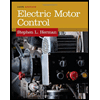
Concept explainers
List the advantages of the use of two-wire control devices.
Explanation of Solution
A two-wire control circuit can be a pressure switch, toggle switch, simple switch, limit switch, float switch, or a thermostat which breaks or makes a connection to a motor through definite on and off positions.
The advantage of two-wire control devices is that the motor is operated (or controlled) by an automatic control device without requiring the presence of a human operator. For example, if the motor is stopped by power failure while the contacts are closed, the two wire control device will not open, that remains in a closed condition. Therefore, the motor can restart when the power is restored.
Conclusion:
Thus, the advantage of the use of two-wire control devices is explained.
Want to see more full solutions like this?
Chapter 17 Solutions
EBK ELECTRIC MOTOR CONTROL
- Solve this problem and show all of the workarrow_forwardA 3 km long multimode step index fibre operating at a bandwidth of 4 Mhz has a core refractive index of 1.48 and a refractive index difference of 1 %. Evaluate the rms pulse broadening per kilometer which results from chromatic dispersion.arrow_forwardFind the Thevenin Equivalent of the circuit below, show all steps;arrow_forward
- Find the Thevenin Equivalent Circuit of the following and find the current through R_L, show all steps;arrow_forwardFind the Thevenin Equivalent Circuit of the circuit below and the current through R_L , show all steps;arrow_forwardFind the Norton Equivalent of the below and the voltage across R_L, show all steps;arrow_forward
- Use Mesh Analysis to find the current through the laod resistor R_L. Show all steps;arrow_forwardFind Thevenin Equivalent of the circuit below and the current through the load resistor R_L. Show all steps;arrow_forwardIf = 5000 A actual time IDMT ---R,, Reand R3 The Tsm relays R, and R3 Draw The characteistic relays time margin between Tsm = 0.5 RCT=500/1 CS-125% TSM = 2 TSM = 0.2 and -0.6 R2 CTS = 500/1 Cs=100% Tsm=0.4 R3 CTS = 400/1 Cs=125% TSM = 2arrow_forward

 Electricity for Refrigeration, Heating, and Air C...Mechanical EngineeringISBN:9781337399128Author:Russell E. SmithPublisher:Cengage Learning
Electricity for Refrigeration, Heating, and Air C...Mechanical EngineeringISBN:9781337399128Author:Russell E. SmithPublisher:Cengage Learning

